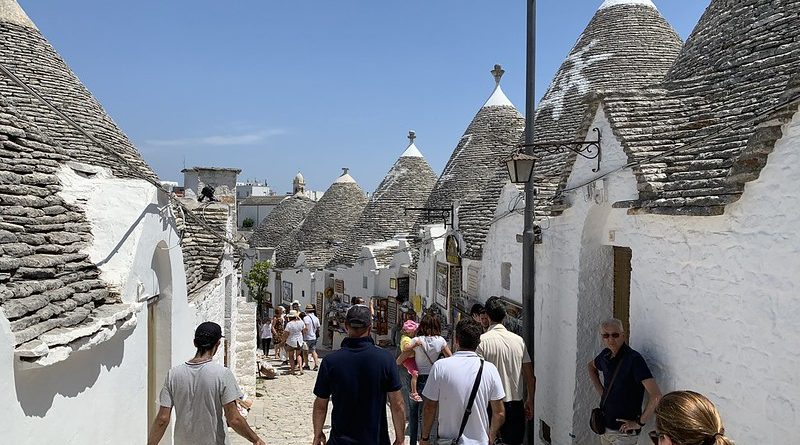The Past, Present & Future of Alberobello’s Iconic Trulli
A Trullo (plural, Trulli) is a small stone hut with a conical roof unique to Italy’s Puglia region. They have become a key architectural feature within the region, and are symbolic of the simple and unfussy style of Italy’s rural agricultural population and culture.
History of Trulli
The beginnings of this dry stone hut with a conical roof are widely debated among historians and architects alike. Some say they were modelled on Roman burial mounds or tombs and strikingly similar structures known as ‘Dolos’ have been found as far away as Turkey.
The oldest known trulli of the land can be found in Alberobello, where some date back to the 14th Century. Built almost entirely from Limestone (which is abundant in the region) and without the use of mortar allowed for quick and inexpensive construction. It is widely believed that the houses were constructed in such a way that they could be easily dismantled in time for the arrival of the taxman from Naples, so as to avoid paying taxes to live there!
 Their construction made for humble dwellings, but they had everything they needed. The ovens and fires are built into the construction, and the light colour meant that they remained cool in the long, hot summers that the region is known for. It is believable that the extreme climate has much to do with how these unique buildings became so ubiquitous within the region.
Their construction made for humble dwellings, but they had everything they needed. The ovens and fires are built into the construction, and the light colour meant that they remained cool in the long, hot summers that the region is known for. It is believable that the extreme climate has much to do with how these unique buildings became so ubiquitous within the region.
Trulli were generally constructed as field shelters, providing shelter for people, animals and provisions from the summer heat, or as permanent dwellings or storage by small proprietors or agricultural labourers.
The golden age of trulli building however was the nineteenth century, especially its final decades, which were marked by the development of wine growing and a greater proportion of the land being used for agricultural purposes.
Trulli were often complete with ancient pagan, jewish, christian and sun-worshiping symbols at the peak of their conical roof. Historians debate as to why such symbols were marked onto the roofs, but one popular belief is that they brought luck and divine protection to the habitants.
What is certain is that Puglia’s trulli are an extraordinary example of mans ingenuity.
Trulli Today
Today, while they still serve a traditional storage purpose, they are more frequently used as homes, holiday homestays and tourist attractions.
In the town of Alberobello, in the province of Bari, you can find whole districts containing dense concentrations of trulli. One such district is Monti, which has over 1000 trulli gracing its streets. Alberobello has consequently become one of the region’s most popular tourist sites.
In recent years, many local proprietors have taken advantage of this unique and lucrative business opportunity. Local businessman, Guido Antoinetta was one of the first to do just that. He spent time renovating some of the near derelict trulli into ‘minimalistic’ B&B’s for very little expense. His renovated trulli broadly appeal to Northern Europeans looking for wholesome and ‘authentic’ cultural holidaying experiences in the beautiful southern Italian countryside.
Of course, many other trulli owners and locals have invested in this opportunity, and Alberobello is experiencing its revival. The town itself is also protected by UNESCO, which not only helps to preserve this fantastic feat of humankind, but also promotes trulli as one of the wonders of the world.
Local hoteliers also saw great opportunity in Alberobello’s trulli and purchased them by the handful in order to offer more of a ‘resort’ experience – the Apulian way! There are many accommodation options for someone hoping to stay in Alberobello.
Trulli in the future
Unfortunately, Alberobello is not immune to the pressures of a rapidly growing tourism sector, and the cracks of overtourism are already starting to appear.
Alberobello, while previously relatively inaccessible, is now serviced by most bus tour routes of the region, bringing thousands of extra tourists to the area. Once an authentic southern Italian experience, Monti is more often than not flooded with tourists. While this has proved beneficial to the local economy, it puts a strain on some of this small town’s resources.
Where locals have retained ownership of some of the trulli, a very real problem for them is the cost of renovating the property. Local tradesmen have also benefitted greatly from the trulli revival, however many poorer locals have been priced out of maintaining their homes.
Some researchers argue that a loss of cultural character will only serve to back-fire on the tourism sector in Alberobello eventually. In a region dominated by beach tourism, the ‘off-the-beaten-track’ culture-seeking tourist numbers could very quickly recede again if this small town becomes too busy and less ‘authentic’.
The question is how can Alberobello find its happy medium, where tourism provides a boost to the local economy, but not to its own eventual detriment?
More Information
Read: Masserie – Puglia’s Luxurious Farmhouse Conversions
Images & Story by Ian Cross
Edited by Sofi Pickering




